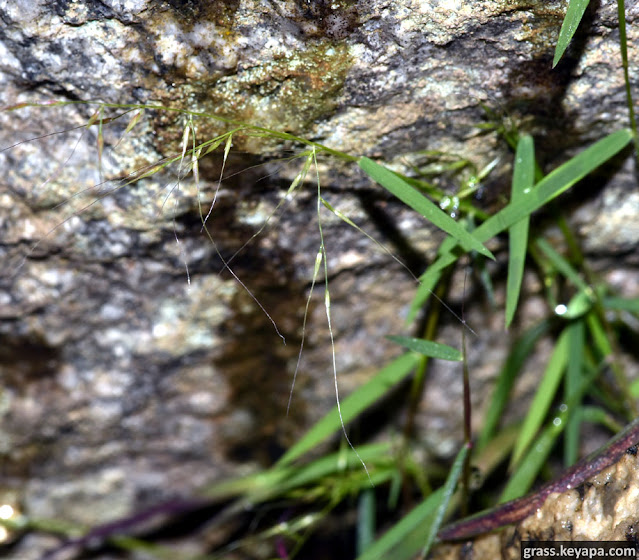 |
| Using a wide angle lens to photograph Machu Picchu scene |
The Sacred Valley (Valle Sagrado) area in Peru boasts some of the most beautiful landscapes in the world. It is dotted with the ancient ruins of Incan structures, their smooth stone walls fitted seamlessly together. Hidden within their intricate puzzle-like geometries lie secret images of animals, including those that this amazing people held sacred, such as snakes, condors, and pumas.
I visited this place last week, including the ruins of the world famous Machu Picchu, as well as the ruins of Pisac, Ollantaytambo, and Saqsaywaman. Remarkably, and especially in the wetter environment of Machu Picchu, the depressions and crevices in the stone walls and boulders held various plants, including some tiny grass species that were wonders to behold.
The genus Ctenium of the subfamily Chloridoideae is one that I have so far seldom encountered in the USA, but I found gorgeous specimens of this grass both in the ruins of Ollantatytambo and in Saqsaywaman.
 |
| Ctenium flowerhead in Saqsaywaman |
Ctenium inflorescence have a characteristic form, with the spikelets in rows on only one side of the flowerhead. Some flowerheads also twist and curve as they mature, creating attractive botanical structures.
 |
| Ctenium growing on mossy soil on rock in Saqsaywaman |
In Saqsaywaman, I found a thriving colony of this grass in a single large boulder. The rock had small depressions filled with moss and soil, and in each of these depressions lived one or more individuals, many of whom drooped as they were bursting with bunches of colorful flowerheads.
 |
| Ctenium inflorescence in Ollantaytambo |
In Machu Picchu, I also found a beautiful tiny species that nestled in the moist crevices of stone walls. I only found these in a localized area in that park, but it was amazing to discover every single one of the individuals as the tour wound its way past that area. The dark green leaves seemed to shyly peek from their rocky cradles, and the spikelets were so tiny (perhaps 1 mm long, not including the long awns) that I had to use full magnification on my macro lens.
 |
| Tiny spikelets of unknown sp growing on rock walls in Machu Picchu |
The tiny spikelets themselves with their single awns remind me of
Muhlenbergia spp. But the overall habit of the plants could not have been more different. Instead of the characteristic thin bladed bunch grass that I have seen as ornamentals and beach residents, these miniscule jewels sported relatively thicker grass blades.
 |
| Tiny spikelets of wall growing unknown sp. in Macchu Picchu |
The difficulty in taking good photos of the tiny specimens were further exacerbated by on and off rain. It was drizzling occasionally when we were there, and many of the flowerheads of the specimens were decorated in droplets of water. The rain also prevented me from using my camera during parts of the tour.
 |
| Tiny grass sp growing out of crevice in moist rock wall in Machu Picchu |
As mentioned in previous posts, the members of the Poaceae are relatively scarce as true epiphytes, probably due to the prevalence of wind pollination in the family. But given even small portions of soil, moss, or other available substrate, it seems that grasses are also fully capable of exploiting these niche habitats.
 |
| Using a wide angle lens to view of the ruins of Ollantytambo |








No comments:
Post a Comment